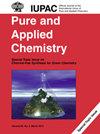不同成熟阶段柑橘果肉脂质成分对健康的益处
IF 2
4区 化学
Q3 CHEMISTRY, MULTIDISCIPLINARY
引用次数: 0
摘要
联合国所有会员国于 2015 年通过的可持续发展目标 (SDG) 3 是 "良好的健康和福祉"。为了促进这一目标的实现,我们采用标准分析技术对未成熟(UR)、即将成熟(AR)和成熟(RP)的中华柚果肉的脂质成分进行了评估。结果表明,在所有受检果肉中都发现了相同的脂肪酸和磷脂。果肉中含量最高的脂肪酸是棕榈油酸,在 UR、AR 和 RP 样品中的含量(%)分别为 26.48、27.82 和 27.14。其次是油酸(25.36 %、29.13 %、28.66 %)、棕榈酸(25.98 %、20.14 %、21.66 %)、亚油酸(12.30 %、11.18 %、11.33 %)、亚麻酸(7.52 %、8.71 %、8.19 %)和硬脂酸(1.95 %、2.73 %、2.72 %),分别为 UR、AR 和 RP 果肉样品。这些样品含有健康的饱和脂肪酸和不饱和脂肪酸,其中不饱和脂肪酸的浓度(71.75 %、76.92 %、75.40 %)在 UR、AR 和 RP 样品中分别较高。果肉中最主要的磷脂(毫克/100 克)是磷脂酰乙醇胺,在 AR、UR 和 RP 样品中的浓度分别为 5.86、6.47 和 6.03。其次是磷脂酰胆碱(4.02 毫克/100 克、4.52 毫克/100 克、4.22 毫克/100 克)、膦酸(3.59 毫克/100 克、4.02 毫克/100 克、3.89 毫克/100 克)、二磷脂酰甘油(3.38 毫克/100 克、3.79 毫克/100 克、3.59 毫克/100 克)、磷脂酰肌醇(1.结果表明,UR、AR 和 RP 果肉中的磷脂酰丝氨酸(1.86 毫克/100 克、2.08 毫克/100 克、1.91 毫克/100 克)和磷脂酰甘油(1.07 毫克/100 克、1.21 毫克/100 克、1.18 毫克/100 克)含量较高。结果表明,在柑橘成熟的各个阶段,柑橘都是一种健康的低脂食品,而且脂肪酸和磷脂的组成随着果肉的成熟而增加。本文章由计算机程序翻译,如有差异,请以英文原文为准。
Health benefit of lipid composition of orange (Citrus sinensis) fruit pulp at different maturation stages
The Sustainable Development Goal (SDG) 3, which was adopted by all United Nations member states in 2015, is ‘Good Health and Wellbeing’. To contribute in the actualization of this goal, the lipid composition of unripe (UR), about to ripe (AR), and ripe (RP) Citrus sinensis fruit pulps were evaluated using standard analytical techniques. The result showed that the same fatty acids and phospholipids were found in all the fruit pulps examined. The most abundant fatty acid in the fruit pulps was palmitoleic acid with concentration (%) of 26.48, 27.82 and 27.14 for UR, AR, and RP samples respectively. This was followed by oleic acid (25.36 %, 29.13 %, 28.66 %), palmitic acid (25.98 %, 20.14 %, 21.66 %), linoleic acid (12.30 %, 11.18 %, 11.33 %), linolenic acid (7.52 %, 8.71 %, 8.19 %), and stearic acid (1.95 %, 2.73 %, 2.72 %) for UR, AR, and RP fruit pulps respectively. The samples contain healthy saturated and unsaturated fatty acid with the concentration of unsaturated fatty acid (71.75 %, 76.92 %, 75.40 %) being prominent in UR, AR, and RP samples respectively. The most prominent phospholipids (mg/100 g) in the fruit pulps was phosphatidylethanolamine with concentrations of 5.86, 6.47, and 6.03 for AR, UR, and RP samples respectively. This was followed by phosphatidylcholine (4.02 mg/100 g, 4.52 mg/100 g, 4.22 mg/100 g), phosphatic acid (3.59 mg/100 g, 4.02 mg/100 g, 3.89 mg/100 g), diphosphatidylglycerol (3.38 mg/100 g, 3.79 mg/100 g, 3.59 mg/100 g), phosphatidylinositol (1.92 mg/100 g, 2.24 mg/100 g, 2.21 mg/100 g), phosphatidylserine (1.86 mg/100 g, 2.08 mg/100 g, 1.91 mg/100 g) and phosphatidylglycerol (1.07 mg/100 g, 1.21 mg/100 g, 1.18 mg/100 g) for UR, AR and RP fruit pulps respectively. The result revealed that Citrus sinensis is a healthy low fat food at every maturation stage and that the fatty acid and phospholipid composition increased as the fruit pulp ripened.
求助全文
通过发布文献求助,成功后即可免费获取论文全文。
去求助
来源期刊

Pure and Applied Chemistry
化学-化学综合
CiteScore
4.00
自引率
0.00%
发文量
60
审稿时长
3-8 weeks
期刊介绍:
Pure and Applied Chemistry is the official monthly Journal of IUPAC, with responsibility for publishing works arising from those international scientific events and projects that are sponsored and undertaken by the Union. The policy is to publish highly topical and credible works at the forefront of all aspects of pure and applied chemistry, and the attendant goal is to promote widespread acceptance of the Journal as an authoritative and indispensable holding in academic and institutional libraries.
 求助内容:
求助内容: 应助结果提醒方式:
应助结果提醒方式:


